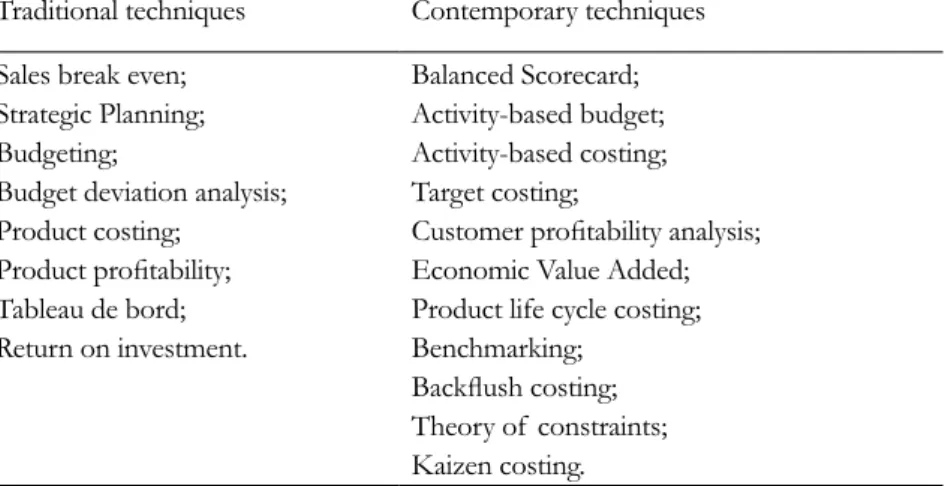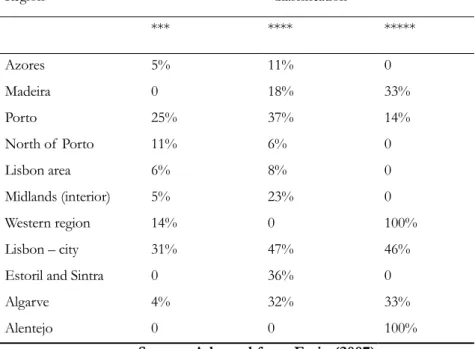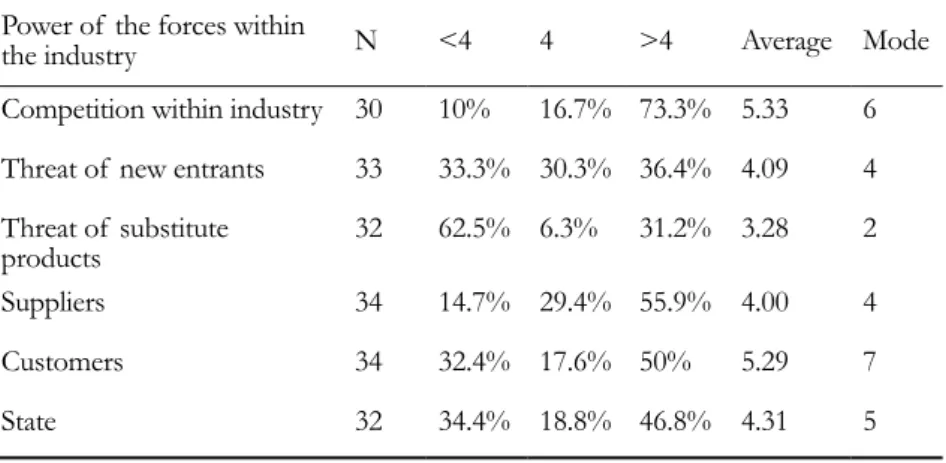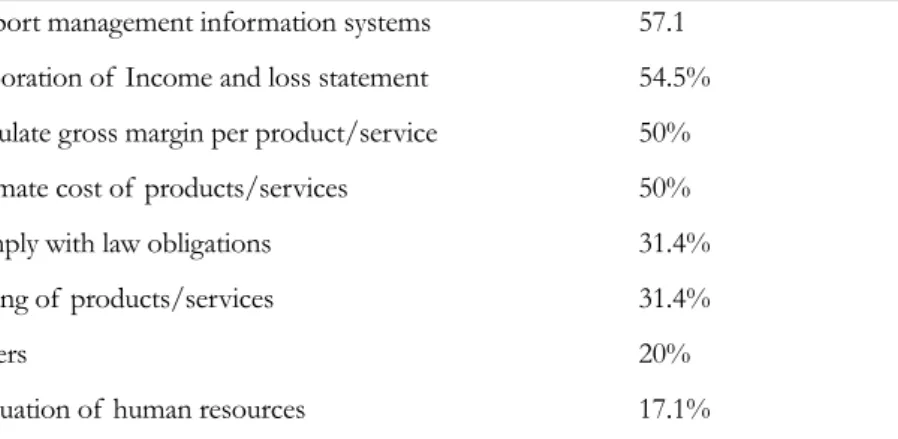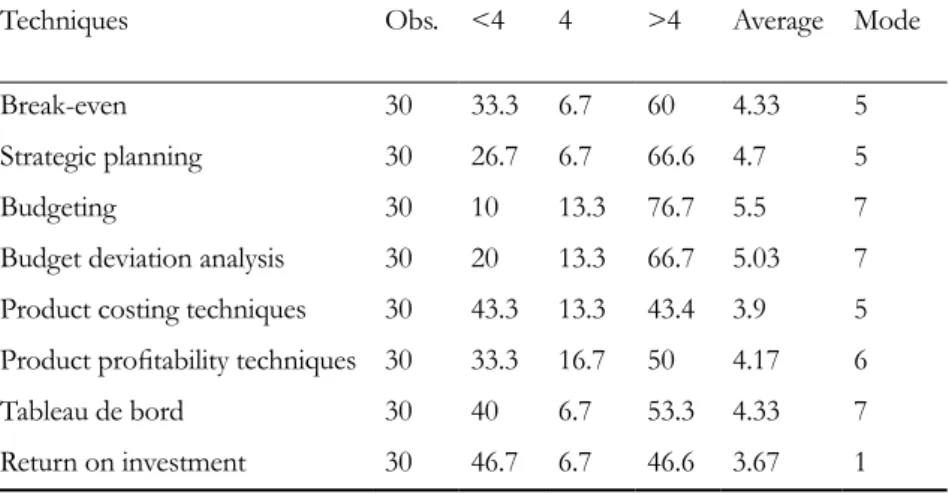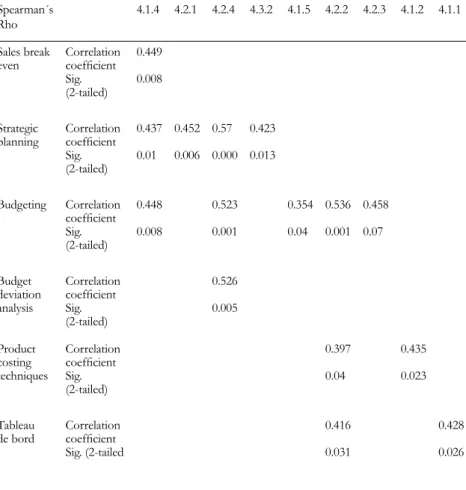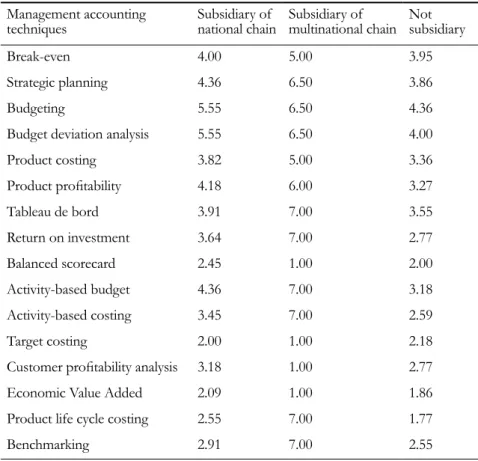110 www.ejthr.com
Research EJTHRTourism
European Journal of
Tourism, Hospitality and Recreation Research EJTHRTourism
European Journal of Tourism, Hospitality and Recreation
© 2010 Polytechnic Institute of Leiria. All rights reserved Printed in Portugal
MaNaGEMENT aCCOuNTiNG
PraCTiCES iN THE POrTuGuESE
lOdGiNG iNduSTrY
1luís lima Santos
Conceição Gomes Nuno arroteia Polytechnic Institute of Leiria, Portugal
AbstrAct: Nowadays the increase in competition within the hotel and lodging industry is
becoming more notorious, thus making more relevant the decision making process for man-agers, concerning the effective use of accounting tools to provide the necessary framework of information for their decisions. This study has the purpose of characterizing management accounting techniques in Portugal, identifying the traditional and contemporary techniques, the use of USALI, if the decision makers are satisfied with the information available, and de-termine which factors influence the industry to adopt a certain technique. Keywords:
manage-ment accounting, lodging industry, uniform system of accounts for the lodging industry, USALI.
resumen: Hoy en día es cada vez más notorio el aumento de la competencia en la
indus-tria de hostelería, lo que hace más relevante la toma de decisiones para los directivos, en lo que respecta a la utilización eficaz de las herramientas de contabilidad para proporcionar el entorno necesario de información para sus decisiones. Este estudio con el propósito de ca-racterizar las técnicas de gestión de contabilidad en Portugal, identificando las técnicas tradi-cionales y contemporáneas, el uso de USALI, si los tomadores de decisiones están satisfechos con la información disponible, y determinar qué factores influyen la industria a adoptar una determinada técnica. Palabras clave: contabilidad de gestión, industria de hostelería, sistema uniforme de cuentas para la industria hotelera, USALI.
INTRoDUCTIoN
Management accounting techniques have evolved in order to re-spond to the increasing challenges imposed by the management and the competitive economy. Nevertheless, the traditional techniques have been the ones with vastest use and adoption, with the contemporary techniques being adopted at a slower rate (Adler et al., 2000).
Thus it is verified that the difference between theory and practice of management accounting, being the contemporary techniques well developed in theoretical terms, in contrast with their relatively reduced adoption within companies (Jones, 2008).
All authors are teachers in the School of Tourism and Maritime Technology (ESTM) at the Polytechnic Institute of Leiria (IPL), Portugal; Luís Lima Santos and Conceição Gomes are associate professors and Nuno Arroteia is lecturer. All authors are active members of the GiTUR - Tourism Research Unit of the IPL.
Some authors suggest that management accounting techniques are different among companies from different industries (Torrecilla et al., 1996; Downie, 1997; Shields, 1998; Williams & Seaman, 2001; Drury & Tayles, 2005), presenting arguments that cause this diversity:
Product life cycle;
Structure of costs, technology and production; Intensity of competition;
Uncertainty and price flexibility;
Competitive strategies and organizational designs.
In the literature several studies may be found, that refer to the de-terminants that make a company opt for some management account-ing techniques. The fact of a company beaccount-ing in a highly competitive market (Tayles & Walley, 1997), and also organizational variables such as communication, coordination, decentralization and formalization (Elmore, 1990; Luft & Shields, 2003) influence the management ac-counting techniques adopted by companies worldwide.
The size of a company (measured through sales volume or number of employees) is also a factor that influences the management account-ing techniques in a company (Clarke et al., 1999; Adler et al., 2000).
Another aspect to take into account is that subsidiaries of multina-tional companies tend to adopt contemporary management accounting techniques at a faster pace. This means that relations among compa-nies influence the adoption of certain management accounting tech-niques, particularly when there is a foreign parent company (Clarke et al., 1999; Malmi, 1999; Clarke & Mullins, 2001; o’ Connor et al., 2004). one may question if the management accounting techniques adopt-ed by hotels are different from the ones adoptadopt-ed by other companies, and which are the determinants that influence hotels to adopt certain techniques.
According to Pavlatos and Paggios (2009), there is a growing de-sire to understand the practice of management accounting in hotels, and these techniques have an important role in their decision making process (oliveira et al., 2008).
As a consequence of several specificities of the hotels, the infor-mation required by managers to make decisions is different from other industries (Mia & Patiar, 2001). Hotels need a special attention, because they have a diverse scope of activities, being both service providers and goods providers (Silva, 2007).
The use of management accounting information is important to al-low the optimization of the decision making processes by hotel man-agers, due to the fact that they face a big competition (Downie, 1997). Hotels have two sources of information: market research and account-ing information. The ideal is that this information could be aligned and coordinated, thus supporting managers (Downie, 1997).
This economic activity is characterized by having a great volatility in demand and fixed costs structure, perishable goods, high competi-tion and a great diversity of services, due to the heterogeneity of cli-ents (Downie, 1997; Mia & Patiar, 2001).
Concerning the competitive environment, hotel units face direct and indirect competition (Mia & Patiar, 2001). oliveira et al. (2008) men-tion that competimen-tion plays an important role in influencing the intro-duction of new accounting techniques in the industry.
The management accounting techniques, according to Ferreira (2002) may be divided into traditional and contemporary (Table 1).
Table 1. Traditional versus contemporary accounting techniques
Traditional techniques Contemporary techniques Sales break even;
Strategic Planning; Budgeting;
Budget deviation analysis; Product costing; Product profitability; Tableau de bord; Return on investment. Balanced Scorecard; Activity-based budget; Activity-based costing; Target costing;
Customer profitability analysis; Economic Value Added; Product life cycle costing; Benchmarking;
Backflush costing; Theory of constraints; Kaizen costing.
Phillips (1996) concludes that Strategic Planning is widely mentioned in the field of hotel management, as well as Performance evaluation. He remarks that the Strategic Planning existent in hotels is quite in-complete, since it is commonly an expansion of the financial budget with less emphasis on strategic issues.
Jones (2008) confirms this idea concluding that Budgeting is the common technique widely used by hotels. Cruz (2007) concludes that budgets are a valid tool for the budgeting control process within a ho-tel, thus remarking that budgets used in hotels have some specific as-pects when compared to the budgets elaborated by other industries.
Hotel chains are nowadays in a strong competitive environment, thus according to Cruz (2007), planning is an essential tool for their management and budgets a part of the process. They should not be rigid but flexible. Due to the internationalization of hotel chains op-erations, a common accounting technique is Benchmarking, allowing the comparison among different business units (hotels).
Cruz (2007) suggests other techniques that have a good influence in the management of hotels, such as Balances Scorecard, Activity-based budget, Activity-based costing, and Customer profitability analysis.
Downie (1997) refers that the Break-even analysis should be more developed, as well as the Customer profitability analysis per market segment. He remarks that there is an interrelation among some man-agement accounting techniques, defending that in order to implement the Customer profitability analysis per market segment, it is more rel-evant to use Activity-based costing than the traditional cost centre ap-proach, meaning that there should be a change in the cost affecting process. This corroborates the idea of integrating marketing strategy with accounting information.
Cost management and control is a commonly used technique adopt-ed by hotel managers analyzadopt-ed by oliveira et al. (2008), with the pur-pose of supporting the decision-making process.
Lee and Kim (2009) analyzed if the Economic Value Added tech-nique influenced the market profitability for the hotel industry, but found out that this technique was not a good way to measure this.
Pavlatos and Paggios (2008) conducted research in Greece, concern-ing the accountconcern-ing techniques adopted by hotel units. They concluded that traditional techniques are widely used when compared to the less widespread contemporary techniques. The most widely used techniques were Budgeting, Budget deviation analysis, Product costing techniques and Product profitability analysis. The techniques with a moderate us-age were Return on investment, Break-even and Strategic Planning.
Concerning the contemporary accounting techniques, the most widely used is Customer profitability analysis, and with moderate usage the Economic Value Added. Less used were the Activity-based cost-ing, Target costcost-ing, Balanced Scorecard, Benchmarkcost-ing, Activity-based budget and Product life cycle costing techniques. Techniques such as Backflush costing, Kaizen costing and Theory of constraints were not approached in this study.
In Portugal, Gomes (2007) analyzed the accounting techniques used by industries in different sectors, where the lodging industry was also represented. The most used traditional accounting techniques were Budgeting, Budgeting deviation analysis, Tableau de Bord and return on investment. The contemporary techniques are less used, although Balanced Scorecard, Activity-based budgeting, Activity-based costing, Target costing and Benchmarking have some relevance.
Pavlatos and Paggios (2007) conducted research about the usage of USALI in Greek hotels. They concluded that 53.3% of hotels be-longing to multinational hotel chains used USALI, compared to only 2.9% of national hotels.
This system is also used by some Portuguese hotels. This fact can be verified in a study developed by AHP (Portugal Hotels Association), mentioned by Faria (2007) (Table 2).
Table 2. Use of USALI in Portugal
Region Classification *** **** ***** Azores 5% 11% 0 Madeira 0 18% 33% Porto 25% 37% 14% North of Porto 11% 6% 0 Lisbon area 6% 8% 0 Midlands (interior) 5% 23% 0 Western region 14% 0 100% Lisbon – city 31% 47% 46%
Estoril and Sintra 0 36% 0
Algarve 4% 32% 33%
Alentejo 0 0 100%
Source: Adapted from Faria (2007)
Lima Santos et al. (2010) analyzed the accounting techniques used by ho-tels in the western region of Portugal, and concluded that management ac-counting is widely used by management, being the most widespread tradi-tional techniques. Concerning the use of USALI, there are evidences of a progressive knowledge and use of this Framework in the support and sim-plification of information processing.
Management accounting is gaining more importance through all business sectors, and the trend is also visible within the lodging industry and hotels. Management accounting techniques are more important to support the deci-sion-making process, even though the traditional techniques are increasingly adopted when compared to the contemporary ones. USALI, as a framework, is also gaining support particularly among multinational hotel chains.
Empirical Study
In 2008 the hotel and lodging industry in Portugal represented 4% of the nation’s GDP (INE, 2008). It is notorious for the increase in
the number and quality of these equipments nationwide, and the in-crease in competition within the business.
Thus the management of these businesses is increasingly concerned with the effectiveness of their decision-making process, and manage-ment accounting as a managemanage-ment function must provide decision makers the information required to support this process.
Management accounting, by its turn, supports hotels to improve their performance, thus becoming relevant to analyze management ac-counting practices used by them, particularly which instruments and techniques and their evolution.
In this context, this study is justified with the increasing need for accurate and actual information of the hotels operating in Portugal.
This study began with the object being the hotels in the western region of Portugal (Santos et al., 2010), and though the results were satisfactory, it was decided to extend the object to business units at a national level.
This study has the objective of characterizing management account-ing techniques in the Portuguese lodgaccount-ing industry, particularly in ho-tels, identifying the techniques adopted and the purpose of adopting certain techniques, the deepness of their use, the degree of satisfac-tion of management with these techniques and their adequacy for the decision-making process, and their expectations in improving them in the future.
It is also another purpose of this work to understand the extent to which the industry adopts and uses the Uniform System of Accounts for the Lodging Industry (USALI). This framework allows a hotel to structure its accounting information in an adequate way to analyze and make management decisions, assuring a better comparison of in-formation and benchmarking within the sector at international level. Its adoption is generalized in the world, with emphasis to the United States of America (Pavlatos and Paggios, 2009).
Methodology
The present research project has selected, as object of study, hotels in Portugal. The sample includes 35 hotels, which were analyzed in the years 2009 and 2010, equally distributed in the sub categories of ho-tels, apartment-hotels and hostels.
This research article deals particularly with questions of the type: Who? What? Where? How many? According to Yin (2003), all these types of questions can be answered by the method of questionnaire.
Since one of the main disadvantages of the questionnaire method is the low rate of respondents, it was decided to conduct personal
inter-views, made by groups of students of the Tourism and Hotel manage-ment degree at the Polytechnic Institute of Leira – School of Tourism and Maritime Technology (IPL/ESTM), supervised by the teachers of the scientific fields of financial accounting and management account-ing. The questionnaire structure was adopted from Gomes (2007), and the data was processed using SPSS. Ultimately a univariate and bivari-ate analysis will take place in order to demonstrbivari-ate the proposed ob-jectives of the research project.
Results
In this study, 35 hotels from different categories and regions from Portugal were analyzed. From these, 11 belong to national chains, 2 are subsidiaries of multinational hotel chains. The annual turnover ranges from 16.000€ to 60.000.000€.
We used the framework of Porter (1985) to analyze the industry forces and added an extra force derived from the influence of the State, in order to understand the relative influence of each force affecting the industry. We conclude that the competition within the industry is the strongest force, with an average value of 5.33, followed by the power of customers. In these two competitive forces the mode is 6 and 7 re-spectively, meaning that the majority of inquiries considered the power of these forces as being “high” and “very high” (Table 3).
Table 3. Relative power of the forces affecting the industry
Power of the forces within
the industry N <4 4 >4 Average Mode
Competition within industry 30 10% 16.7% 73.3% 5.33 6 Threat of new entrants 33 33.3% 30.3% 36.4% 4.09 4 Threat of substitute
products 32 62.5% 6.3% 31.2% 3.28 2
Suppliers 34 14.7% 29.4% 55.9% 4.00 4
Customers 34 32.4% 17.6% 50% 5.29 7
State 32 34.4% 18.8% 46.8% 4.31 5
Note. Scale: 1 low or negligible to 7 very high
Concerning the intensity of competitors within the industry, this is more evident in terms of price, being mode 6 “high” and the choice of most of the respondents (Table 4).
Table 4. Intensity of competitors
Intensity of competitors N <4 4 >4 Average Mode Price competition 35 8.6% 11.4 80% 5.43 6 Labor force competition 35 64.7% 23.5% 11.8% 3.09 3 Buying of goods competition 35 70.6% 23.5% 5.9% 2.41 1 Promotion competition 35 22.9% 22.9% 54.2% 4.46 6
Note. Scale: 1 low or negligible… 7 very high
Concerning their competitive strategies (Porter, 1985), the main strategy followed by the respondents is the differentiation of their offer, though some hotels use both cost leadership and differentiation as their strategies (Table 5).
Table 5. Competitive strategies of hotels
Competitive strategy Nr. of hotels %
Cost leadership 10 28.6
Differentiation of products and services 18 51.4
Both strategies 7 20.0
Total 35 100.0
of the 35 respondents, 85.7% (30) have implemented and use man-agement accounting processes. The 5 units that do not use this prac-tice are very small hotels that are not subsidiaries of neither national nor multinational hotel chains.
Concerning the use of USALI, it is used with different depths by 15 of the respondents.
The hotels use management accounting mainly with the purpose of supporting their decision-making process and the budgeting proc-ess (Table 6).
Table 6. Purpose of using management accounting
Purpose (by order of importance) Percentage
Decision-making 65.7%
Budgeting 60%
Support management information systems 57.1 Elaboration of Income and loss statement 54.5% Calculate gross margin per product/service 50% Estimate cost of products/services 50%
Comply with law obligations 31.4%
Pricing of products/services 31.4%
others 20%
Evaluation of human resources 17.1%
Being aware that the information supplied by management account-ing is adequate to several management functions (Table 7), we conclude that the functions this information is more adequate to, are supporting the decision-making process and knowledge of costs structure, with a score of 5.43 and 5 respectively.
Table 7. Adequacy of management accounting to management functions
Management functions obs. <4 4 >4 Average Estimate cost of products/services 30 20% 10% 70% 5 Pricing of products/services 30 23.3% 22.9% 53.8% 4.43
Decision-making 30 10% 10% 80% 5.43
Evaluation of human resources 30 73.3% 3.3% 23.4% 2.9 Profitability of products and services 30 23.3% 16.7% 60% 4.57 Profitability of customers 30 33.3% 16.7% 50% 3.8 Profitability of markets 30 26.7% 26.7% 46.6% 3.97
Note. Scale: 1 Inadequate... 7 Adequate
As previously discussed, management accounting has a vast scope of techniques, some of which are considered to be traditional accounting techniques. From these, the ones that are most used by the respond-ents are Budgeting, Budget deviation analysis and Strategic Planning (Table 8), with 76.7%, 66.7% and 66.6% respectively.
Table 8. Traditional accounting techniques used by respondents
Techniques obs. <4 4 >4 Average Mode
Break-even 30 33.3 6.7 60 4.33 5
Strategic planning 30 26.7 6.7 66.6 4.7 5
Budgeting 30 10 13.3 76.7 5.5 7
Budget deviation analysis 30 20 13.3 66.7 5.03 7 Product costing techniques 30 43.3 13.3 43.4 3.9 5 Product profitability techniques 30 33.3 16.7 50 4.17 6
Tableau de bord 30 40 6.7 53.3 4.33 7
Return on investment 30 46.7 6.7 46.6 3.67 1
Note. Scale: 1 no use… 7 extensive use
Concerning the contemporary accounting techniques, the results are opposed to the previous ones, with almost all of the techniques hav-ing a score of average use below the null value, except for the Activity-based budgeting with an average of 4.23 (Table 9), followed by Activ-ity-based costing, Customer profitability analysis and Benchmarking.
Table 9. Contemporary accounting techniques used by respondents
Techniques Obs. <4 4 >4 Average Mode
Balanced Scorecard 30 76.7 3.3 20 2.27 1
Activity-based budget 30 33.3 6.7 60 4.23 1
Activity-based costing 30 50 3.3 46.7 3.47 1
Target costing 30 76.7 10 13.3 2.23 1
Customer profitability analysis 30 53.3 20 26.7 3.10 1
Economic Value Added 30 80 10 10 2.03 1
Product life cycle costing 30 73.3 10 16.7 2.53 1
Benchmarking 30 60 0 40 3.23 1
Backflush costing 30 86.7 10 3.3 1.57 1
Theory of constraints 30 80 13.3 6.7 1.83 1
Kaizen costing 30 90 10 10 1.5 1
Note. Scale: 1 no use… 7 extensive use
As a consequence of the fact that Backflush costing, Theory of constraints and Kaizen costing are techniques with practically no use among inquiries, they were not subject to the analysis that follows.
We will continue the presentation of conclusions concerning the analysis of factors that influence the competitiveness of hotels and (Ta-ble 2 and 3), and their influence in the choice of traditional accounting techniques by the respondents.
Table 10. Association between variables that characterize competition and the use of traditional accounting techniques Spearman´s
Rho 4.1.4 4.2.1 4.2.4 4.3.2 4.1.5 4.2.2 4.2.3 4.1.2 4.1.1
Sales break
even Correlation coefficient
Sig. (2-tailed)
0.449 0.008
Strategic
planning Correlation coefficient Sig. (2-tailed) 0.437 0.01 0.452 0.006 0.57 0.000 0.423 0.013 Budgeting Correlation coefficient Sig. (2-tailed) 0.448 0.008 0.523 0.001 0.354 0.04 0.536 0.001 0.458 0.07 Budget deviation analysis Correlation coefficient Sig. (2-tailed) 0.526 0.005 Product costing techniques Correlation coefficient Sig. (2-tailed) 0.397 0.04 0.435 0.023 Tableau
de bord Correlation coefficient
Sig. (2-tailed
0.416 0.031
0.428 0.026
Note. 4.1.4 – Suppliers; 4.2.1 – Price competition ; 4.2.4 – Promotion competition; 4.3.2 – Suppliers; 4.1.5 – Customers; 4.2.2 – Labor force competition; 4.2.3 – Buying of goods competition; 4.1.2 – Threat of new entrants; 4.1.1 – Competition within industry.
As we are in the presence of ordinal variables, we have chosen Spearman´s Rho in order to make a correlation analysis. According to Pestana and Gageiro (2003), Spearman´s Rho measures the intensity of the relation among variables. Fink (1995) states that Spearman´s Rho is commonly used to describe the relation among two ordinal variables or one ordinal and other numeric variable.
Due to the fact that this coefficient is not sensitive to asymmetric distributions, it does not require normal populations. This coefficient gives a score between -1 and 1, and the closer to these extremes, the biggest correlation among variables.
When analyzing Spearman´s Rho of the traditional accounting tech-niques with other variables that characterize the competitiveness within the industry, we found some moderate associations, thus the correla-tion coefficient is between 0.39 and 0.58.
Bearing in mind that the correlation is positive, we can conclude that generically, the hotels that use the traditional accounting techniques are the ones that recognize facing bigger competition (Table 10).
Another aspect that was analyzed in the revision of literature was that the subsidiaries of multinational hotel chains tend to adopt the contemporary accounting techniques, when compared to other hotels. Bearing that in mind, we analyze the sample to verify whether we could corroborate the same conclusion.
We have chosen the Kruskal-Wallis test, which is used to test the equality hypothesis (Pestana & Gageiro, 2003). We have defined the following hypothesis: H0: The distribution of the variable among all types of hotels (not subsidiary, subsidiaries of a national chain, sub-sidiaries of a multinational chain) is equal in central tendency, and Ha: The hotels are not equal in central tendency. The hypotheses were ap-plied to the whole sample.
According to the Kruskal-Wallis test, the null hypothesis is not re-jected, except for the techniques Return of Investment, Activity-based budget, Activity-based costing and Product life cycle costing, where the null hypothesis is rejected to a significance level of 0.05. In the three groups considered, these techniques have a different central tendency.
It is clear in Table 11 that these techniques are of more common use in the subsidiaries of multinational hotel chains. This confirms that the hotels subsidiaries of multinational chains are more developed in terms of the use of management accounting techniques.
The annual sales turnover could also be a variable that influences the use of accounting techniques. We decided to analyze the intensi-ty of the relation between the adoption of management accounting techniques and annual sales turnover, and we have chosen Spearman´s Rho. The coefficients that have been found are all positive, and we can confirm that the hotels with higher annual sales turnover adopt a large number of accounting techniques. Note that some accounting tech-niques have significant coefficients, bigger than 0.5 (Break even, Stra-tegic Planning, Budgeting, Budget deviation analysis, Activity-based budget, Activity-based costing and Product life cycle costing.
Table 11. Average use of accounting techniques according to the variable subsidiary
Management accounting
techniques Subsidiary of national chain Subsidiary ofmultinational chain Notsubsidiary
Break-even 4.00 5.00 3.95
Strategic planning 4.36 6.50 3.86
Budgeting 5.55 6.50 4.36
Budget deviation analysis 5.55 6.50 4.00
Product costing 3.82 5.00 3.36 Product profitability 4.18 6.00 3.27 Tableau de bord 3.91 7.00 3.55 Return on investment 3.64 7.00 2.77 Balanced scorecard 2.45 1.00 2.00 Activity-based budget 4.36 7.00 3.18 Activity-based costing 3.45 7.00 2.59 Target costing 2.00 1.00 2.18
Customer profitability analysis 3.18 1.00 2.77
Economic Value Added 2.09 1.00 1.86
Product life cycle costing 2.55 7.00 1.77
Benchmarking 2.91 7.00 2.55
CoNCLUSIoN
Management accounting techniques are continuously developing in order to respond to the challenges that organizations face. According to Pavlatos and Paggios (2009), the interest in management account-ing within the lodgaccount-ing industry is increasaccount-ing, and it is considered very important in the decision-making process (oliveira et al., 2008).
This research allows us to conclude that, nowadays, accounting is a management tool incorporated in the daily management practices of hotels, and useful to support the decision-making process in sev-eral aspects.
Most of the hotels that have answered our inquiry use accounting techniques, with the main purpose of providing information to sup-port management control.
The traditional accounting techniques are used frequently, which corroborates previous studies from Pavlatos and Paggios (2008), where the same evidences were found in Greek hotels.
In the hotels that were subject to this study, there is a mismatch be-tween theory and practice of management accounting, because some of the contemporary techniques are not known and thus not adopted by the hotels. This fact confirms the conclusions of Jones (2008). Nev-ertheless, the contemporary accounting techniques more frequently adopted by the hotels are the ones more present in the literature (Ac-tivity-based costing and Ac(Ac-tivity-based budget).
The conclusions that we came to are, to some extent, close to the conclusions of other researchers in this field. Phillips (1996) refers that Strategic planning is a frequent technique adopted within the industry. Jones (2008) refers that Budgeting is the most used technique. Cost control is a technique widely used by hotel managers (oliveira et al. (2008), with the purpose of supporting the decision-making process. Pavlatos and Paggios (2008) have found that the traditional accounting techniques more frequently adopted were Budgeting, Budget deviation analysis, Product costing and Product profitability analysis.
By using Spearman´s Rho we verified that there is a moderate as-sociation between variables that characterize the competition within the sector and the degree of adoption of accounting techniques. With that in mind, we confirm that competitiveness within the industry has a positive influence the management accounting practices adopted by hotels, an idea previously transmitted by Tayles and Walley (1997).
We also have found that the adoption of accounting techniques by the hotels is influenced by the fact that they are subsidiaries of a mul-tinational hotel chain, as well as by their annual turnover.
In conclusion, we found three factors that influence management accounting practices in hotels, and believe that there is an opportuni-ty to analyze these findings in more detail, in future research projects.
REFERENCES
Adler, R., Everett, A., & Waldron, M. (2000). Advanced management ac-counting techniques in manufacturing: Utilization, benefits and barriers to implementation. Accounting Forum, 24(2), 131-150.
Clarke, P., Hill, N., & Stevens, K. (1999). Activity-based costing in Ire-land: Barriers to, and opportunities for, change. Critical Perspectives on Account-ing, 10(4), 443-468.
Clarke, P., & Mullins, T. (2001). Activity-based costing in the non-manufac-turing sector in Ireland: a preliminary. Irish Journal of Management, 22(2), 1-18. Cruz, I., (2007). How might hospitality organizations optimize their per-formance measurement systems? International Journal of Contemporary Hospital-ity Management, 19(7), 574-588.
Domingues, C. M. (1997). Prontuário Turístico. Instituto Nacional de For-mação Turística
Downie, N. (1997). The use of accounting information in hotel market-ing decisions. International Journal of Hospitality Management, 16(3), 305-312.
Drury, C., & Tayles, M. (2005). Explicating the design of overhead absorp-tion procedures in UK organizaabsorp-tions. The British Accounting Review, 37(1), 47-84. Elmore, R. (1990). The linkage between organizational size and the man-agement accounting system. Akron Business and Economic Review, 21(3), 69-80. Faria, A (2007). A contabilidade aplicada o sector hoteleiro: uma perspec-tiva histórica. In IV Jornada de História da Contabilidade.
Ferreira, A. (2002). Management accounting and control systems design and use: An exploratory study in Portugal. PhD thesis. The Management School, Lancaster University, Lancaster.
Gomes, C. (2007). A contabilidade de gestão e o custeio baseado nas actividades nas grandes empresas portuguesas. Os determinantes do custeio baseado nas actividades. Phd Thesis.Universidade do Minho, Braga.
Instituto Nacional de Estatística (2010). Empresas em Portugal – 2008. Re-trieved from http://www.ine.pt
Instituto Nacional de Estatística (2009). Estatísticas do Turismo – 2008. Re-trieved from http://www.ine.pt.
Instituto Nacional de Estatística (2008). Estatísticas do Turismo – 2007. Re-trieved from http://www.ine.pt.
Jones, T. (2008). Improving hotel budgetary practice – a positive theory model. International Journal of Hospitality Management, 27, 529-540.
Lee, S., & Kim, W. (2009). EVA, refined EVA, MVA, or traditional per-formance measures for the hospitality industry. International Journal of Hospi-tality Management, 28, 439-445.
Luft, J., & Shields, M. (2003). Mapping management accounting: Graph-ics and guidelines for theory-consistent empirical research. Accounting, Orga-nizations and Society, 28 (2-3), 169-249.
Malmi, T., (1999). Activity-based costing diffusion across organization: An exploratory empirical analysis of finnish firms. Accounting Organization and Society, 24(8), 649-672.
Mia, Lokman e Patiar, Anoop (2001). The use of management accounting systems in hotels: An exploratory study. Hospitality Management, 20, 111-128.
o’Connor, N., Chow, C., & Wu, A. (2004). The adoption of Western management accounting/controls in China’s state-owned enterprises during economic transition. Accounting, Organizations and Society, 29(3-4), 349-375.
oliveira, E., Silva, C., Campelo, K., & Silva, A. (2008). Utilização da gestão de custos para tomada de decisão: Um estudo em hotéis de Porto de Galinhas no municí-pio de Ipojuca-PE. 18º Congresso brasileiro de contabilidade. Retrieved from http://www.congressocfc.org.br.
Porter, M. (1985). Competitive advantage. Creating and sustaining superior perfor-mance. The. New York: Free Press.
Pavlatos, o., & Paggios, I. (2009), A survey of factors influencing the cost system design in hotels. International Journal of Hospitality Management, 28, 263-271.
Pavlatos, o., & Paggios, I (2008). Traditional and recent-developed management accounting techniques in the hopitality industry: Evidence from Greece. Retrieved from http://papre.ssrn.com
Pavlatos, o., & Paggios, I. (2007). Cost accounting in greek Hotel enterprises: An empirical approach. Retrieved from http://mpra.ub.uni-muenchen.de
Pestana, M., & Gageiro, J. (2003). Análise de dados para ciências sociais – A complementaridade do SPSS: Lisboa: Edições Sílabo.
Phillips, P. A. (1996). Strategic planning and business performance in the quoted UK hotel sector: Results of an exploratory study. International Journal of Hospitality Management, 15(4), 347- 362.
Santos L. L., Gomes C., Arroteia N., Silva P., & Coelho J. (2010). Práticas de contabilidade de gestão nas unidades hoteleiras do Oeste. XV Workshop em Conta-bilidade e Controlo de gestão “Memorial Raymond Konopka, Évora.
Santos L.L., Gomes C., Arroteia N., Silva P. & Coelho J. (2009). Caracteri-zação do perfil económico e financeiro das unidades hoteleiras do Oeste. III Congresso Internacional de Turismo, Policopiado, IPL/ESTM, Peniche.
Shields, M. (1998). Management accounting practices in Europe: A per-spective from States. Management Accounting Research, 9(4), 501-513.
Silva, L., (2007). Contabilidade hoteleira em uma visão de gerenciamento de custos. Retrieved from http://artigocientífico.tebas.kinhost.net/artigos
Tayles, M., & Walley, P. (1997). Integrating manufacturing and manage-ment accounting strategy: Case study insights. International Journal Production Economics, 53(1), 43-55.
Torrecilla, A., Fernandez, A., quiros, J., & Mosquero, M (1996). Manage-ment accounting in Spain: Trends in thought and practice. In A. Bhimani (Ed.), Management Accounting European Perspectives (pp. 180-198). oxford: ox-ford University Press, 180-198.
Williams, J., & Seaman, A. (2001). Predicting change in management ac-counting systems: National culture and industry effects. Acac-counting, Organiza-tions and Society, 26(4-5), 443-460.
Yin, R. (2003). Case study research – design and methods. London: SAGE Publications.
Submitted: 20th September 2010 Final version: 24th October 2010 Accepted: 05th
